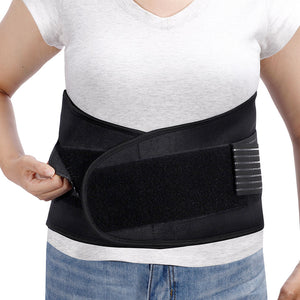Should I Sleep With a Wrist Brace on for Tendonitis?

Tendonitis causes severe pain in the tissues around the joints in the wrists. Writing, carrying objects, and even turning a doorknob with a wrist affected by tendonitis can be painful. We can control our movements during the day, but our movements are unconscious during sleep. Perhaps when sleeping, we also need wrist braces for tendonitis to the care of our wrists.
We can answer the question: should I sleep with a wrist brace on for tendonitis? By specifying how the support will be helpful? Using wrist support during sleep is a precaution to prevent your wrist from turning with a sudden movement. Unconscious movements during sleep can cause pain in your wrist and even a relapse of the injury.

The Definition, Symptoms, and Causes of Tenosynovitis
Tendons are strong, fibrous tissues connecting each other to muscles and bones. The synovial sheaths on the tendons prevent the tendons from rubbing against each other and the outer surface from wearing out during movement. These sheaths allow tendons to move smoothly. However, repetitive strain can damage the synovial sheaths. This damage can lead to inflammation, known as "tenosynovitis."
♢ Symptoms of Tenosynovitis
- Pain:Affected individuals typically report pain along the tendon, which is often exacerbated by movement
- Swelling:The inflamed synovial sheath may cause visible swelling or a palpable increase in size around the tendon.
- Stiffness:The inflammation can also result in stiffness, limiting the normal range of motion and making it challenging to flex or extend the joint.
- Noise:Some people may hear a grating or popping sound, known as crepitus, when they move the affected joint.
♢ Causes of Tenosynovitis
Tendonitis usually results from straining your tendons with repetitive behaviors. For example, tasks or sports activities that require constant gripping trigger the symptoms. Writing continuously for days and weeks sometimes causes injuries in the thumb and wrist area in academics and students. Sports activities such as basketball and baseball invite tendonitis due to intense training and match schedules. Finally, poor posture, such as slouching at your desk or holding your wrist in a reverse position for long periods, may contribute to tendonitis.Given the impact of daily activities and posture on tendon health, it's essential to consider appropriate support to manage symptoms effectively. This begs the crucial question: Should I sleep with a wrist brace on for tendonitis?
Wrist Health During Sleep
While we might not be consciously aware of it, our sleep posture can significantly impact our wrist health, especially when dealing with tendonitis. Should I sleep with a wrist brace on for tendonitis? Understanding how sleeping positions affect your wrist can help you answer this question.- Side-Lying: This common position can cause the wrist to bend sharply, leading to strain on the tendons as they stretch across the joint. Over time, this can worsen the symptoms of tendonitis.
- Prone Sleeping: Lying face down often requires the wrist to be in a state of extension or rotation, which can place additional stress on the tendons and potentially aggravate tendonitis.
- Supine Sleeping:Sleeping on your back generally permits the wrist to maintain a neutral position, which is beneficial for reducing strain. What’s important is to avoid arm overextension or bending which may impact the wrist negatively.
- Unconscious Repetitive Movements: The constant shifting or repositioning of the wrist may not be felt immediately, but they can lead to increased inflammation and discomfort upon waking. For individuals with tendonitis, the cumulative effect of these unconscious actions can disrupt the healing process and prolong recovery.
The Benefits of Wrist Support During Sleep for Tendonitis
You move around unconsciously in bed during sleep, and wrist support keeps your wrist stable, preventing tendonitis symptoms from worsening. How to wear a tendonitis brace for the wrist correctly: here's a guide to proper wear:
✓ Find the Right Fit
The first thing is to choose the right size for your wrist, typically ranging from 7-12 inches in circumference. It's best to try on braces for comfort and fit before purchasing. Wrist braces are made differently for the left and right hands. Therefore, you should pick the right product for the hand with trouble.

✓ Positioning
Slide your hand through the opening of the wrist brace. Ensure the palm pad rests comfortably on your palm. Secure the wrist straps around your wrist, starting with the one closest to your hand. Adjust the straps for a snug and stabilizing fit. Make sure the brace stabilizes your wrist joint without digging into your skin.
✓ Additional Measures
Wearing a wrist brace all day will speed up healing by keeping your wrist immobile for 24 hours. However, with a few additional precautions and practical applications, you can get the maximum benefit during sleep.
Introduce Fivali Wrist Braces for Tendonitis
Choosing the right wrist brace for sleep support during tendonitis will make a significant difference in your comfort level. Should I sleep with a wrist brace on for tendonitis? Doctors confirm the benefits of wrist braces and their effect on the healing process. All that remains is to choose the product that suits you best. We offer a variety of the best wrist braces for tendonitis suitable for nighttime use:
1. Fivali Carpal Tunnel Wrist Brace with Thumb Support 1 Pack FWH01
Our Fivali Carpal Tunnel Wrist Brace with Thumb Support 1 Pack FWH01 features a lightweight splint that immobilizes your wrist in a neutral position. With its wrist and thumb brace for tendonitis, it minimizes unwanted movements that could aggravate tendonitis. The targeted support for the thumb area makes it a good option if your tendonitis affects the base of your thumb. It's also a suitable product if you feel pain under your thumb when gripping something.

2. Fivali Thumb Splint Brace 1 Pack FWR02
Fivali Thumb Splint Brace 1 Pack FWR02 offers adjustable compression and a removable splint for customizable support during sleep. Its flexibility enables you to target specific areas of discomfort in your wrist while maintaining a neutral position. Its breathable mesh fabric and gel bars between the thumbs make it the healthiest and most comfortable product on the market.
A Multifaceted Approach to Tendonitis Treatment
Tendonitis leaves you wondering: Should I sleep with a wrist brace on for tendonitis? But this is a small part of the treatment. Your first stop should be your doctor, and you should receive the treatment process. In this section, we will talk about recommendations on what to do:
✦ Ice CompressWhen you receive a blow to any point on your body, the first precaution is a cold compress. The situation is no different in tendonitis treatment. You can reduce the effect of inflammation and pain with 15-20 minutes of ice compress several times a day.
✦ Drug TreatmentDrug treatment should only be applied with a doctor's prescription. Over-the-counter painkillers only serve to temporarily reduce the effect of pain. Tendonitis treatment can often be completed with ice compress, exercises, and using a wrist brace.
✦ Physical TherapyPhysical therapy involves stretching and relaxing your wrist by periodic movements. If you have experienced an advanced injury, you may need to see a physiotherapist. Special exercises and local treatments can be applied to you to speed up the treatment process.
For those who are worried about “Should I sleep with a wrist brace on for tendonitis?” We, Fivali, could give you the perfect solution. Our expertly designed products cater to those with tendonitis, ensuring comfort and effective healing. Visit our website to discover how our innovative products can enhance your recovery and improve your overall well-being.
-
Posted in
Healthy Lifestyle, Joint, Pain, Recovery













